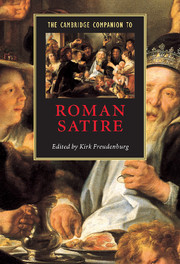Book contents
- Frontmatter
- Introduction
- Part I Satire as literature
- Part II Satire as social discourse
- Part III Beyond Rome
- 14 Roman satire in the sixteenth century
- 15 Alluding to satire
- 16 The Horatian and the Juvenalesque in English letters
- 17 The “presence” of Roman satire
- Conclusion
- Key dates for the study of Roman satire
- Bibliography
- Index
- Series list
15 - Alluding to satire
Rochester, Dryden, and others
from Part III - Beyond Rome
Published online by Cambridge University Press: 28 May 2006
- Frontmatter
- Introduction
- Part I Satire as literature
- Part II Satire as social discourse
- Part III Beyond Rome
- 14 Roman satire in the sixteenth century
- 15 Alluding to satire
- 16 The Horatian and the Juvenalesque in English letters
- 17 The “presence” of Roman satire
- Conclusion
- Key dates for the study of Roman satire
- Bibliography
- Index
- Series list
Summary
Histories of English literature tell us that the defining terms of Restoration (1660) poetry were established by John Dryden (1631-1700). Samuel Johnson (1709-1784), in his not entirely uncritical Life, makes Dryden’s transformation of English poetry analogous to Augustus' Rome: “he found it brick, and he left it marble.” He is the seminal poet of his age. So too the masterworks of Restoration satire are Dryden’s Mac Flecknoe and Absalom and Achitophel, and his later Discourse concerning the Original and Progress of Satire set out the ways in which the Roman satirists were to be read and adapted right through the eighteenth century. Pope’s (1688-1744) and Johnson’s conceptions of Horace and Juvenal derive directly from a typology that Dryden popularizes, if not invents. This should, then, be an essay on Dryden. But it is not; for the brilliance of Dryden’s work has tended to leave us a distorted picture of what satire, or indeed Horace and Juvenal, might have meant to a Restoration reader; we look back at the Restoration and see Dryden; a contemporary reader of satire would have seen Dryden and others experimenting with classical satire’s legacy, sorting out its manners and place in the hotly contested literary and social politics of the Restoration. That said, I cannot offer a significantly less inflected version of Restoration satire here; merely another view from its slightly seamier underside, and here too Dryden plays a role …
- Type
- Chapter
- Information
- The Cambridge Companion to Roman Satire , pp. 261 - 283Publisher: Cambridge University PressPrint publication year: 2005
- 4
- Cited by

